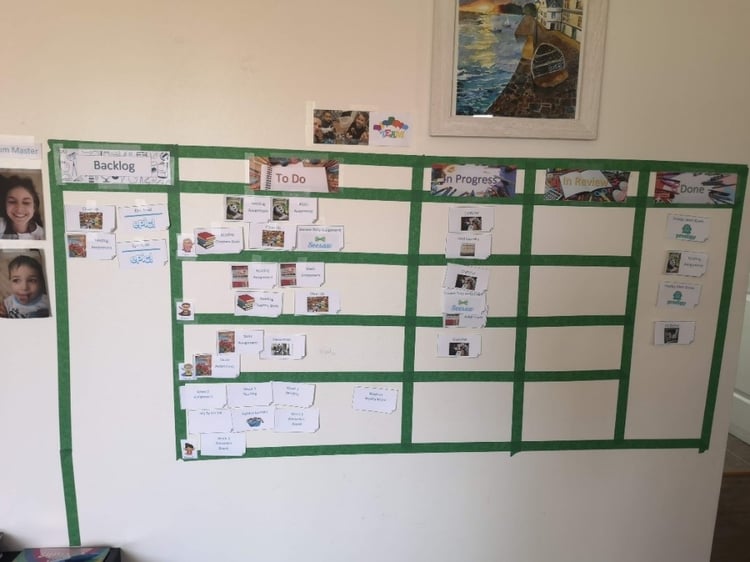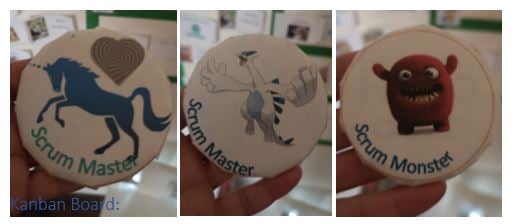(Dedicated to all working parents out there, you are doing a great job)
After my first week of lockdown during the COVID-19 pandemic of 2020, I came to realize a harsh truth about zombies… they are real and I was becoming one!
As a single mom of 3 adorable little monsters kids (who I still love) - a 9-year old daughter who doesn’t stop talking for more than a second (usually to swallow food), and two highly energetic sons, 7 and 3, who seem to be on a mission to break something, including their own limbs, all with an attention span of a fruit fly - I wasn’t able to do any work during the day.
I had to work at night when they were asleep and after a whole day of chasing/breaking up fights/trying to get them to learn/breaking up fights/feeding/cleaning/ breaking up fights/acquiring new habits of whipping everything twice/breaking up more fights, I was feeling stretched pretty thin.
That’s when I realized that being locked up with your kids 24/7 is all it takes to turn you into a “zombie”.
Full extent of the situation
I'm not making excuses; it's just when they weren’t doing something that requires my presence, I had to cook for them, or clean after them, and these little monsters eat constantly! Not a lot but all the time... “What’s for lunch? Can I have a snack? Can I have a candy? I don’t like my candy; can I have his candy? No, you cannot.... I don’t like his candy either!! Can I have another candy? Can I have a snack?” x3
“Taking work home” moved to a whole new level:
Initially I tried to stick to a “normal” routine, but very quickly the little monsters have found their “why”:
“Why should we go to bed early, there is no school tomorrow?”
“Why should I do this assignment, there is no school?”
“Why should I change out of my pajamas, there is no school?”
You get the point.
Different ages, multiple different assignments from different teachers on different platforms – it continues to be a lot to keep up with.
I tried to consult with other parents, read up on ideas of how to motivate young kids to learn, but mostly how to combine work and homeschooling: there were many suggestions out there starting from “ease up and let them do whatever while you work (school can wait)” to “stack up on wine” all followed by my favorite: “we’re all in the same boat” (strongly disagree: while I agree that we’re all floating, some have a 5 star yacht while others try to hang on to a log of wood).
Routine:
There are countless articles out there explaining how routine is important for kids and adults as one. Especially when everything is changing, because it gives a sense of security. On the other hand, a strict schedule didn’t work for us. Bribe and/or threats didn’t work either. I suspected they would likely rebel once they realized there is 3 of them and only one of me and I would spend the rest of my life tied up in a basement. 😊
I wanted to motivate them.
And so after what felt like our fifth month into the first week of isolation, I was ready to make a change; and I then realized that I could incorporate an Agile mindset to my at-home challenges.
Saving the world:
I’ve since dedicated a good portion of a wall in my living room for a Kanban board. I used painter’s tape to outline the Kanban Table, printed out column names, our team’s picture, our acting Scrum Master’s photo, assignments, and have now set my “team” up for Agile Bootcamp: The Home Edition.

Why Agile?
The main principle of the Agile methodology, as the name suggests, is to respond to change rather than following a plan.
The “plan” was no longer relevant. We had to adjust fast to the new “normal” rather than stick to the old way of learning. Kids as young as 1st graders had to learn how to use newly introduced platforms, learn how to use available technology in new ways and adapt to new ways of learning, namely distant education.
Why Scrum?
Scrum is a widely used Agile framework. It’s simple enough for young kids to follow and could be adjusted for educational purposes.
Scrum Theory:
According to Scrum Theory, as it is described in the Scrum Guide:
“Scrum is founded on empirical process control theory, or empiricism.
Three pillars uphold every implementation of empirical process control: transparency, inspection, and adaptation.”
Transparency created the biggest change to our routine: in the previous week, I would ask the kids to jump to whatever new assignment I would receive from their teachers. There were countless emails coming in with different assignments, suggestions, ”tell me how is your day going” videos which I would panic over and get them to do right away. I had to slow down and stop jumping on every email that was coming in, instead I decided to prioritize. Transparency allowed us to see what was coming down the pipe, what needed to be done, what was urgent and what could wait, as well as what was achieved, what needed more focus and what they needed more help with.
Inspection - I explained to them that we will all inspect each other’s work. They will inspect mine just as well. So far, the dishes are being washed to their satisfaction. But as we kept practicing Agile, I’ve made an interesting observation: they started noticing more of what I am doing around the house, recognize it more and even help out without me asking.
Adaptation - a chore or an assignment that was not completed to the satisfaction of the reviewer was returned and asked to be fixed. I explained this procedure to them upfront, and we’ve experienced less drama over wrong answers and a redo of an assignment.
Scrum Team:
Teachers are our stakeholders and I am the Product Owner, as I have the information on the work that needs to be completed, but mostly because it’s my game, I’m the only adult here and I called it first!!
The Development Team needs to be cross functional, according to the Scrum Guide. We are definitely a cross functional bunch. It also a self-organizing team and I’ve explained that they will be responsible for planning their own day. They can choose the assignments or chores as they like but need to be considerate of the priority of the tasks.
I’ve decided to have a weekly Scrum Master, and to give each of my children a chance to be a Scrum Master. My daughter was our first Scrum Master. She fully embraced the “Master” part of the title and after letting her boss her little brothers around for half a day I called a meeting and explained that a Scrum Master is actually a “servant leader”, this was taken literally and the tables have quickly turned for my little dictator. After letting my boys boss her around (she deserved it), I called another meeting and tried to explain to a 9, 7 and 3 year old the role of a Scrum Master (which I had to take a 2-day course for) in few minutes (they were getting sick of the meetings by that point).
Kanban Board:
All our weekly assignments are laid out in the Backlog column at the start of a day and are being pulled into individual rows under To Do column, then one is selected to work on and moved to In Progress column, later when finished it is moved to an In Review column and when reviewed could be moved to Done.
Scrum Framework
Sprint:
“The heart of Scrum is a Sprint, a time-box of one month or less”. (The Scrum Guide)
Our sprint is a one-week increment. I though this is the ideal length, since it aligns with schoolwork. “Sprints contain and consist of the Sprint Planning, Daily Scrums, the development work, the Sprint Review, and the Sprint Retrospective”. (The Scrum Guide)
Daily Scrum:
Every morning after breakfast we meet by our Kanban board. We each take turns presenting our day. We pull relevant items from the Backlog into our To Do column, we explain what we are planning on doing that day, choose the first task for the day and move it into the In Progress column. At the end of the meeting we change out of our pjs (at least most of us do) and get to work. We update the board as we progress in our tasks throughout the day and collect the assigned points for each task. To keep them motivated I’ve promised I will be converting the points into money and they will be allowed to buy a toy of their choice.
Sprint Review:
“A Sprint Review is held at the end of the Sprint to inspect the Increment and adapt the Product Backlog if needed. During the Sprint Review, the Scrum Team and stakeholders collaborate about what was done in the Sprint” (The Scrum Guide).
During our meeting, we discuss the past sprint’s progress. We review what issues we had and how we solved them. We adjust the backlog with new items, if such were received, and we discuss priority of the backlog items.
Retrospective:
“The Sprint Retrospective is an opportunity for the Scrum Team to inspect itself and create a plan for improvements to be enacted during the next Sprint.
The purpose of the Sprint Retrospective is to:
- Inspect how the last Sprint went with regards to people, relationships, process, and tools;
- Identify and order the major items that went well and potential improvements; and,
- Create a plan for implementing improvements to the way the Scrum Team does its work. “
(The Scrum Guide)
During our Retrospective meeting we each take turns to discuss the next points:
- What we liked? Crafts, walks outside, playing together.
- What we didn’t like? When mommy changed the priority on tasks after tasks were already chosen (in my defense it was the first week of Agile implementation and all they had on their to do lists were crafts, math games and Epic equivalent of YouTube Kids with an educational content).
- How to improve? Help each other.
- What should we keep doing? Having fun.
Sprint Planning:
“The work to be performed in the Sprint is planned at the Sprint Planning. This plan is created by the collaborative work of the entire Scrum Team.” (The Scrum Guide)
During the Sprint Planning meeting, we discuss what we accomplished last sprint, we plan our next sprint, and play Scrum poker to assign points to new tasks that were added to the backlog. My Agile prodigies quickly figured out that the more points they assign to a simpler task the faster they will get to their target amount. I’m proud of their collaboration on this, but a bit worried too: like I said, three of them only one of me.
Epilogue:
The Agile methodology is highly adaptive to change due to its short increments. Everyone has clear visibility of the tasks to be completed. The Monsters team is actively involved in decision-making which gives them a sense of control. We make sure to listen to each other’s opinions and try to improve, which makes the work more enjoyable. They help each other more, check each other’s work and learn to receive criticism as part of the process without letting their feelings to get hurt. The productivity has been continuously improving each sprint (49 vs. 60 individual points in 2 consecutive sprints). We have the desired structure without committing to a strict schedule.
The little monsters still eat around the clock and they still fight and talk nonstop, but they are learning to be more independent, they also realizing that mommy needs to work and when mommy is in a meeting, breaking the furniture is not allowed. We learn, we play, we grow.
And this is how Agile will save the world from zombie apocalypse one Kanban board at a time.
Spread the word!
Sivan Loevsky





Submit a Comment